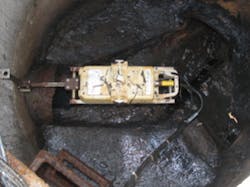Wild Kingdom
Home to more than 3,000 animals representing 600 species, the Cleveland Metroparks Zoo is a popular attraction enjoyed by people of all ages. Behind the scenes, its facilities operations department works tirelessly to ensure that visitors have a safe and enjoyable visit. This includes the monitoring of wastewater flow.
In order to accurately determine quarterly wastewater processing fees owed to the Northeast Ohio Regional Sewer District (NEORSD), which handles its wastewater treatment, the zoo relies on its flow monitoring system to accurately capture flow data.
“We have two pump houses that pump all of the sewage from the zoo,” said Ann Kaminsky, former systems and records administrator for facilities operations. “These wastewater flows are all monitored by our main flowmeter, and a couple of smaller buildings are submetered. After passing the meters, the wastewater continues out through a 12-in. pipe to the street,” where it joins the NEORS collection system.
For more than 20 years, the zoo had been using a submerged sensor metering approach to determine its flow rates. In 2007, however, it determined that this approach was increasing its bills, and it began looking for a more accurate approach.
“I'm sure [the submerged metering system] wasn't as reliable as it could have been, and I think that edged our numbers up,” said Kaminsky.
In addition, a slight bend in the sewer line created a swale, which also affected the ability of the submerged sensor to accurately capture flow data.
As a result, the zoo decided to change its monitoring approach and purchased a FLO-DAR AV sensor that utilizes noncontact radar technology. The FLO-DAR has the ability to accurately monitor flow from above the fluid rather than in it. This approach eliminates sensor fouling and other issues that are common with submerged sensors.
“Because the sensor was not submerged, our guys wouldn't have to be constantly pulling the sensor out for cleaning,” said Kaminsky.
In this billing-specific stationary monitoring scenario, the FLO-DAR sensor was installed in a manhole and its accompanying data-logging unit—the FLO-STATION flow monitor—was located in the zoo’s service building and operated with a permanent AC power source.
Immediately upon installation, NEORSD personnel became concerned that the zoo's new monitoring system's readings were inaccurate because of a significant decrease in the amount of flow reported. The decrease was particularly noticeable when compared to the readings it had been accustomed to seeing for the past 20 years.
“It was frustrating because we had just spent money on this new meter and yet [NEORSD was] telling us the readings could not be right,” said Kaminsky. “I could understand their concern because the new numbers were so low that I was kind of skeptical too.”
Looking for a solution, Kaminsky contacted Tim Carrig of Carrig & Associates, a local Hach Company flow-monitoring representative. Carrig visited the site multiple times with Hach field service personnel and determined that the new FLO-DAR monitoring system was, indeed, providing accurate readings. NEORSD however, was still not convinced. So it brought in its own flowmeter, placed it just downstream from the newly installed FLO-DAR and left it to compare data between the two systems.
“We were at a real impasse, but in the end it was very much NEORSD's solution that helped bring this to a good resolution,” said Kaminsky. “Lo and behold, our numbers [from the FLO-DAR] were actually a little bit higher than [NEORSD's] numbers, which was probably due to compensation for the curvature in our line.”
As a result, the Zoo received a significant refund for flow rate overcharges.
“Not only has the [FLO-DAR permanent metering solution] more than paid for itself, but I now have peace of mind knowing that when I turn in a flow data report, it will reflect the right numbers and be accepted,” said Kaminsky.
Now, more than seven years since the FLO-DAR monitoring system was installed, Kaminsky has moved on from the zoo, but her replacement continues to be just as satisfied with its performance. Better yet, the zoo continues to save on its quarterly wastewater processing fees and, after seven years, that adds up nicely.
